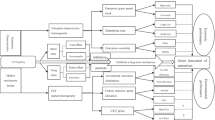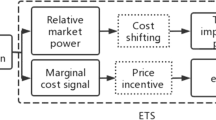Abstract
More and more emphasis is placed on the common development of economy and ecological environment in China’s development strategy, and one of the key solution is green technology innovation of enterprises. This paper takes the carbon emission trading scheme carried out in China in 2013 as a quasi-natural experiment and uses the data of China’s A-share non-financial listed companies and the DID method to empirically test the impact of the scheme on enterprise green technology innovation from the micro level. The results suggest that the carbon emission trading scheme has a significant role in promoting enterprise green technology innovation, mainly through the innovation of green practical patents and alternative energy-based patent. Using a series of robustness tests such as dynamic effect test, placebo test, and PSM-DID, it is found that the results are still valid. Further analysis finds that debt financing will weaken the role of carbon emission trading scheme in promoting enterprise green technology innovation. And the carbon emission trading scheme plays a greater role in promoting green technology innovation in state-owned enterprises, enterprises belonging to areas with strong pollution control intensity and high pollution industry.




Similar content being viewed by others
Data availability
The data that support the findings of this study are available from the corresponding author upon reasonable request.
References
Anderson BJ, Convery F, Maria CD (2010) Technological change and the EU ETS: the case of Ireland. Social Science Electronic Publishing 216(1–2):233–238. https://doi.org/10.2139/ssrn.1687944
Bai Y, Qian Q, Jiao J et al (2020) Can environmental innovation benefit from outward foreign direct investment to developed countries? Evidence from Chinese manufacturing enterprises. Environ Sci Pollut Res 27:13790–13808. https://doi.org/10.1007/s11356-020-07819-z
Bian C, Chu Z, Sun Z (2021) A policy simulation analysis on the effects of environmental regulation on enterprise’s green innovation in technology. Journal of Industrial Technological Economics 40(07):12–22
Blackman A, Kildegaard A (2010) Clean technological change in developing-country industrial clusters: Mexican leather tanning. Environ Econ Policy Stud 12:115–132. https://doi.org/10.1007/s10018-010-0164-7
Bovenberg AL et al (1997) Environmental tax reform and endogenous growth. Journal of Public Economics 63(2):207–237. https://doi.org/10.1016/S0047-2727(96)01596-4
Braun E, Wield D (1994) Regulation as a means for the social control of technology. Technology Analysis & Strategic Management 6(3):259–272. https://doi.org/10.1080/09537329408524171
Cao S, Nie L, Sun H, Sun W, Taghizadeh-Hesary F (2021) Digital finance, green technological innovation and energy-environmental performance: evidence from China’s regional economies. J Clean Prod 327:129458. https://doi.org/10.1016/j.jclepro.2021.129458
Chakraborty P, Chatterjee C (2017) Does environmental regulation indirectly induce upstream innovation? New Evidence from India Res Policy 46(5):939–955
Chen S, Zhang J, Liu C (2021) Environmental regulation, financing constraints, and enterprise emission reduction: evidence from pollution Levy standards adjustment. Journal of Financial Research 9:51–71
Chen Y, Yao Z, Zhong K (2022) Do environmental regulations of carbon emissions and air pollution foster green technology innovation: evidence from China’s prefecture-level cities. J Clean Prod 350:131537. https://doi.org/10.1016/j.jclepro.2022.131537
Chen Z, Zhang Y, Wang H et al (2022) Can green credit policy promote low-carbon technology innovation? J Clean Prod 359:132061. https://doi.org/10.1016/j.jclepro.2022.132061
Cui J, Zhang J, Zheng Y (2018) Carbon pricing induces innovation: evidence from China’s regional carbon market pilots. AEA Papers and Proceedings 108:453–457. https://doi.org/10.1257/pandp.20181027
David P, O’Brien JP, Yoshikawa T (2008) The implications of debt heterogeneity for R&D investment and firm performance. Acad Manag J 51:165–181
Dong F, Dai Y, Zhang S et al (2019) Can a carbon emission trading scheme generate the Porter effect? Evidence from pilot areas in China. Sci Total Environ 653:565–577. https://doi.org/10.1016/j.scitotenv.2018.10.395
Dong F, Li Y, Qin C et al (2022) Information infrastructure and greenhouse gas emission performance in urban China: a difference-in-differences analysis. J Environ Manage 316:115252. https://doi.org/10.1016/j.jenvman.2022.115252
Faere R, Grosskopf S Jr, C, (2007) Environmental production functions and environmental directional distance functions. Energy 32(7):1055–1066
He L, Liang X, Yang X, Zhong Z (2019) Can green credit promote the technological innovation of environmental protection enterprises? Financial Economics Research 34(05):109–121
Jiang X, Jia J, Liu Q (2021) Debt structure optimization and corporate innovation: a study from the perspective of corporate bond financing. Journal of Financial Research 4:131–149
Johnstone N, Managi S, Rodrguez MC et al (2017) Environmental policy design, innovation and efficiency gains in electricity generation. Energy Economics 63:106–115
Kneller R, Manderson E (2012) Environmental regulations and innovation activity in UK manufacturing industries. Resource and Energy Economics 34(2):211–235
Lai H, Wang F, Guo C (2022) Can environmental awards stimulate corporate green technology innovation? Evidence from Chinese listed companies. Environ Sci Pollut Res 29:14856–14870. https://doi.org/10.1007/s11356-021-16632-1
Li G, Zhang W, Wang Y (2016) OFDI, Environmental regulation and green technology innovation in China. Sci Technol Manag Res 36(13):227-231+236
Liao Z, Xu C, Cheng H, Dong J (2018) What drives environmental innovation? A content analysis of listed companies in China. J Clean Prod 198:1567–1573. https://doi.org/10.1016/j.jclepro.2018.07.156
Liu Z, Sun H (2021) Assessing the impact of emissions trading scheme on low-carbon technological innovation: Evidence from China. Environ Impact Assess Rev 89:106589. https://doi.org/10.1016/j.eiar.2021.106589
Liu C, Xin L, Li J (2022a) Environmental regulation and manufacturing carbon emissions in China: a new perspective on local government competition. Environ Sci Pollut Res 29:36351-36375. https://doi.org/10.1007/s11356-021-18041-w
Liu C, Xin L, Li J, Sun H (2022b) The impact of renewable energy technology innovation on industrial green transformation and upgrading: beggar thy neighbor or benefiting thy neighbor. Sustainability 14(18):11198. https://doi.org/10.3390/su141811198
Liu D, Chen J, Zhang N (2021) Political connections and green technology innovations under an environmental regulation. J Clean Prod 298:126778. https://doi.org/10.1016/j.jclepro.2021.126778
Lu J, Yan Y, Wang T (2021) The microeconomic effects of green credit policy−from the perspective of technological innovation and resource reallocation. China Industrial Economics 1:174–192. https://doi.org/10.19581/j.cnki.ciejournal.2021.01.010.
Myers SC, Majluf NS (1984) Corporate financing and investment decisions when firms have information that investors do not have. Social Science Electronic Publishing 13(2):187–221
Peng J, Song Y, Tu G, Liu Y (2021) A study of the dual-target corporate environmental behavior (DTCEB) of heavily polluting enterprises under different environment regulations: green innovation vs. pollutant emissions. Journal of Cleaner Production 297:126602. https://doi.org/10.1016/j.jclepro.2021.126602
Porter ME (1991) America’s Green Strategy. Sci Am 4:168
Qi S, Lin Q, Cui J (2018) Do environmental rights trading schemes induce green innovation? Evidence from Listed Firms in China. Econ Res J 53(12):129–143
Ren S, Zheng J, Liu D, Chen X (2019) Does emissions trading system improve firm’s total factor productivity——evidence from Chinese listed companies. China Industrial Economics 5:5–23. https://doi.org/10.19581/j.cnki.ciejournal.2019.05.001.
Shen F, Tao Q, Zhang Y (2022) Directors with overseas background and firm green technology innovation: from the perspective of corporate reputation. Journal of Shanghai University of Finance and Economics 24(03):108–122 https://doi.org/10.16538/j.cnki.jsufe.2022.03.008.
Shi D, Ding H, Wei P, Liu J (2018) Can smart city construction reduce environmental pollution. China Industrial Economics 6:117–135. https://doi.org/10.19581/j.cnki.ciejournal.2018.06.008
Sun Y, Hu H, Jin G (2022) Pollution or innovation? How enterprises react to air pollution under perfect information. Sci Total Environ 831:154821. https://doi.org/10.1016/j.scitotenv.2022.154821
Tao F, Zhao J, Zhou H (2021) Does environmental regulation improve the quantity and quality of green innovation——evidence from the target responsibility system of environmental protection.China Industrial Economics 2:136–154. https://doi.org/10.19581/j.cnki.ciejournal.2021.02.016
Wang F, Chen F (2018) Board governance,environmental regulation and green technology innovation——empirical test based on listed companies in China’s heavy polluting industry. Studies in Science of Science 36(02) :361–369. https://doi.org/10.16192/j.cnki.1003-2053.2018.02.019
Wang X, Chu Xu (2019) External financing and enterprises’ green technology innovation: a study based on the threshold model of firm size. Systems Engineering Theory and Practice 39(08):2027–2037
Wang Y, He L (2022) Can China’s carbon emissions trading scheme promote balanced green development? A consideration of efficiency and fairness. J Clean Prod 367:132916. https://doi.org/10.1016/j.jclepro.2022.132916
Wang G, Wang D (2011) Porter hypothesis, environmental regulation and enterprises’ technological innovation——the comparative analysis between Central China and Eastern China. China Soft Science 1:100–112
Wen J, Feng G, Liu Z (2011) Heterogeneous debt, company size and R&D input. Journal of Financial Research 1:167–181
Xu J, Cui J (2020) Low-carbon cities and firms’ green technological innovation. China Industrial Economics 12:178–196. https://doi.org/10.19581/j.cnki.ciejournal.2020.12.008
Yang X, Jiang P, Pan Y (2020) Does China’s carbon emission trading policy have an employment double dividend and a Porter effect? Energy Pol 142:111492
Yuan Y, Chen Z (2019) Environmental regulation, green technology innovation and the transformation and upgrading of China’s manufacturing industry Studies in Science of Science 37(10) :1902–1911.
Yuan B, Xiang Q (2018) Environmental regulation, industrial innovation and green development of Chinese manufacturing: based on an extended CDM model. J Clean Prod 176:895–908. https://doi.org/10.1016/j.jclepro.2017.12.034
Zhang Y, Zhao Z (2022) Environmental regulations and corporate social responsibility: evidence from China’s real-time air quality monitoring policy. Financ Res Lett 48:102973. https://doi.org/10.1016/j.frl.2022.102973
Zhang J, Geng H, Xu G, Jian C (2019) Research on the influence of environmental regulation on green technology innovation China Population. Resources and Environment 29(01):168–176
Zhao J, Shahbaz M, Dong K (2022) How does energy poverty eradication promote green growth in China? The role of technological innovation. Technol Forecast Soc Chang 175:121384. https://doi.org/10.1016/j.techfore.2021.121384
Zhou F, Wang X (2022) The carbon emissions trading scheme and green technology innovation in China: a new structural economics perspective. Economic Analysis and Policy 74:365–381. https://doi.org/10.1016/j.eap.2022.03.007
Zhu Y, Gao H, Hu Y et al (2022) Can local environmental co nstraints improve enterprise’s green innovation quality? Evidence from Chinese-listed firms. Environ Sci Pollut Res. https://doi.org/10.1007/s11356-022-22161-2
Funding
This research was supported by National Social Science Foundation of China “Research on Industry Selection and Cooperation Path to Promote the Construction of Belt and Road from the Perspective of Regional Value Chain” (21CJL030).
Author information
Authors and Affiliations
Contributions
All authors made significant contributions to the study conception and design. Data collection and methodology were performed by Yongxuan Xue. The first draft of the manuscript was written by Xiaodong Ma and Yongxuan Xue, and both the authors commented on the previous versions of the manuscript. All the authors read and approved the final manuscript.
Corresponding author
Ethics declarations
Ethics approval and consent to participate
Not applicable.
Consent for publication
Not applicable.
Competing interests
The authors declare no competing interests.
Additional information
Responsible Editor: Eyup Dogan
Publisher's note
Springer Nature remains neutral with regard to jurisdictional claims in published maps and institutional affiliations.
Rights and permissions
Springer Nature or its licensor (e.g. a society or other partner) holds exclusive rights to this article under a publishing agreement with the author(s) or other rightsholder(s); author self-archiving of the accepted manuscript version of this article is solely governed by the terms of such publishing agreement and applicable law.
About this article
Cite this article
Ma, X., Xue, Y. How does carbon emission trading scheme affect enterprise green technology innovation: evidence from China’s A-share non-financial listed companies. Environ Sci Pollut Res 30, 35588–35601 (2023). https://doi.org/10.1007/s11356-022-24768-x
Received:
Accepted:
Published:
Issue Date:
DOI: https://doi.org/10.1007/s11356-022-24768-x




